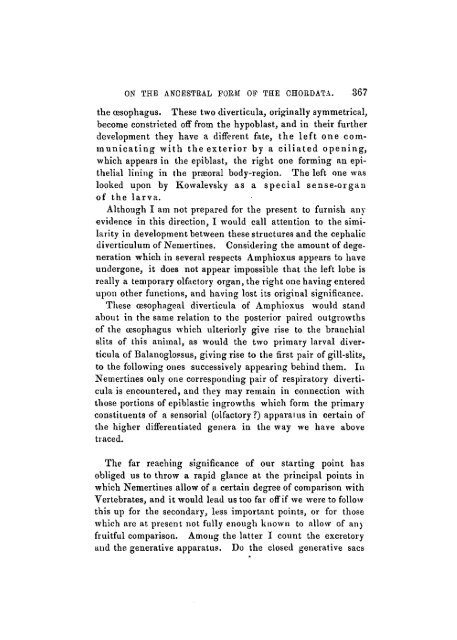On the Ancestral Form of the Chordata.
On the Ancestral Form of the Chordata.
On the Ancestral Form of the Chordata.
Create successful ePaper yourself
Turn your PDF publications into a flip-book with our unique Google optimized e-Paper software.
ON THE ANOESTEAL FORM OF THE OHOBDATA. 367<br />
<strong>the</strong> oesophagus. These two diverticula, originally symmetrical,<br />
become constricted <strong>of</strong>f from <strong>the</strong> hypoblast, and in <strong>the</strong>ir fur<strong>the</strong>r<br />
development <strong>the</strong>y have a different fate, <strong>the</strong> left one communicating<br />
with <strong>the</strong> exterior by a ciliated opening,<br />
which appears in <strong>the</strong> epiblast, <strong>the</strong> right one forming an epi<strong>the</strong>lial<br />
lining in <strong>the</strong> prseoral body-region. The left one was<br />
looked upon by Kowalevsky as a special sense-organ<br />
<strong>of</strong> <strong>the</strong> larva.<br />
Although I am not prepared for <strong>the</strong> present to furnish any<br />
evidence in this direction, I would call attention to <strong>the</strong> similarity<br />
in development between <strong>the</strong>se structures and <strong>the</strong> cephalic<br />
diverticulum <strong>of</strong> Neniertines. Considering <strong>the</strong> amount <strong>of</strong> degeneration<br />
which in several respects Amphioxus appears to have<br />
undergone, it does not appear impossible that <strong>the</strong> left lobe is<br />
really a temporary olfactory organ, <strong>the</strong> right one having entered<br />
upon o<strong>the</strong>r functions, and having lost its original significance.<br />
These cssophageal diverticula <strong>of</strong> Amphioxus would stand<br />
about in <strong>the</strong> same relation to <strong>the</strong> posterior paired outgrowths<br />
<strong>of</strong> <strong>the</strong> cesophagus which ulteriorly give rise to <strong>the</strong> branchial<br />
slits <strong>of</strong> this animal, as would <strong>the</strong> two primary larval diverticula<br />
<strong>of</strong> Balanoglossus, giving rise to <strong>the</strong> first pair <strong>of</strong> gill-slits,<br />
to <strong>the</strong> following ones successively appearing behind <strong>the</strong>m. In<br />
Nernertines only one corresponding pair <strong>of</strong> respiratory diverticula<br />
is encountered, and <strong>the</strong>y may remain in connection with<br />
those portions <strong>of</strong> epiblastic ingrowths which form <strong>the</strong> primary<br />
constituents <strong>of</strong> a sensorial (olfactory?) apparatus in certain <strong>of</strong><br />
<strong>the</strong> higher differentiated genera in <strong>the</strong> way we have above<br />
traced.<br />
The far reaching significance <strong>of</strong> our starting point has<br />
obliged us to throw a rapid glance at <strong>the</strong> principal points in<br />
which Nemertines allow <strong>of</strong> a certain degree <strong>of</strong> comparison with<br />
Vertebrates, and it would lead us too far <strong>of</strong>f if we were to follow<br />
this up for <strong>the</strong> secondary, less important points, or for those<br />
which are at present not fully enough known to allow <strong>of</strong> any<br />
fruitful comparison. Among <strong>the</strong> latter I count <strong>the</strong> excretory<br />
and <strong>the</strong> generative apparatus. Do <strong>the</strong> closed generative sacs

















